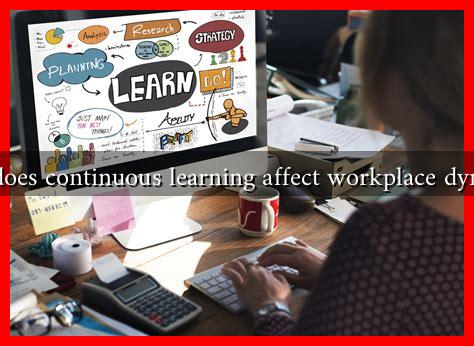-
Table of Contents
How Does Continuous Learning Affect Workplace Dynamics?
In today’s fast-paced and ever-evolving business landscape, continuous learning has emerged as a critical component of workplace dynamics. Organizations that foster a culture of ongoing education not only enhance employee skills but also improve collaboration, innovation, and overall job satisfaction. This article explores the multifaceted impact of continuous learning on workplace dynamics, supported by relevant examples, case studies, and statistics.
The Importance of Continuous Learning
Continuous learning refers to the ongoing, voluntary, and self-motivated pursuit of knowledge for personal or professional development. In the workplace, this can take various forms, including formal training programs, workshops, online courses, and peer-to-peer learning. The significance of continuous learning can be summarized as follows:
- Adaptability: In a rapidly changing environment, employees who engage in continuous learning are better equipped to adapt to new technologies and processes.
- Skill Enhancement: Ongoing education helps employees refine their existing skills and acquire new ones, making them more valuable to the organization.
- Employee Retention: Organizations that invest in their employees’ growth tend to have higher retention rates, as employees feel valued and engaged.
Impact on Collaboration and Team Dynamics
Continuous learning fosters a culture of collaboration and teamwork. When employees are encouraged to learn together, it creates an environment where knowledge sharing becomes the norm. This collaborative spirit can lead to several positive outcomes:
- Enhanced Communication: Learning together helps break down silos, leading to improved communication across departments.
- Increased Trust: Team members who learn together build stronger relationships, fostering trust and camaraderie.
- Collective Problem-Solving: Diverse perspectives brought together through continuous learning can lead to innovative solutions to complex problems.
A case study from Google illustrates this point. The tech giant has implemented various learning initiatives, such as “g2g” (Googler-to-Googler) learning, where employees teach each other skills. This approach has not only enhanced individual capabilities but also strengthened team dynamics, resulting in higher project success rates.
Driving Innovation Through Continuous Learning
Innovation is often the lifeblood of successful organizations. Continuous learning plays a pivotal role in fostering an innovative culture. Here’s how:
- Encouraging Creativity: Employees who are exposed to new ideas and concepts are more likely to think creatively and propose innovative solutions.
- Staying Ahead of Trends: Continuous learning helps organizations stay abreast of industry trends, enabling them to pivot and innovate proactively.
- Empowering Employees: When employees feel empowered through learning, they are more likely to take initiative and contribute to innovative projects.
For instance, IBM has long been recognized for its commitment to continuous learning. The company invests heavily in employee development programs, which has led to numerous innovations, including advancements in artificial intelligence and cloud computing. IBM’s focus on learning has positioned it as a leader in technology and innovation.
Measuring the Impact of Continuous Learning
To understand the true impact of continuous learning on workplace dynamics, organizations can utilize various metrics:
- Employee Engagement Scores: Regular surveys can gauge employee satisfaction and engagement levels before and after implementing learning initiatives.
- Retention Rates: Tracking turnover rates can provide insights into the effectiveness of learning programs in retaining talent.
- Performance Metrics: Analyzing productivity and performance metrics can help assess the impact of continuous learning on overall business outcomes.
According to a report by LinkedIn, companies that invest in employee training see a 24% higher profit margin than those that do not. This statistic underscores the financial benefits of fostering a culture of continuous learning.
Conclusion
In conclusion, continuous learning significantly affects workplace dynamics by enhancing adaptability, fostering collaboration, driving innovation, and improving employee retention. Organizations that prioritize ongoing education create a more engaged and skilled workforce, ultimately leading to better business outcomes. As the business landscape continues to evolve, embracing continuous learning will be essential for organizations aiming to thrive in the future.
For more insights on continuous learning and its impact on workplace dynamics, consider exploring resources from LinkedIn Learning or Coursera.

